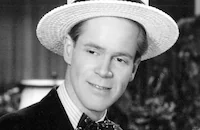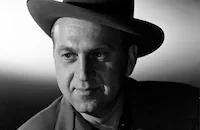The Underworld Story

Brief Synopsis
Cast & Crew
Cyril Endfield
Dan Duryea
Herbert Marshall
Gale Storm
Howard Da Silva
Michael O'shea
Film Details
Technical Specs

Synopsis
At dawn, gangsters drive up to the steps of the Hall of Justice and open fire, killing underworld figure Turk Meyers and injuring district attorney Ralph Munsey. A radio news report reveals that Turk was about to testify against gambling syndicate chief Carl Durham, and that Munsey blames the shooting on the city's newspaper, which published a front-page story about the secret testimony. Reporter Mike Reese, who wrote the story, is fired, and when he cannot find another job, decides to buy half interest in a small newspaper in the exclusive New England suburb of Lakeville. Mike calls on Durham and asks him for the money he needs to invest in the paper, then goes to Lakeville and introduces himself to publisher Cathy Harris and her pressman, George R. "Parkie" Parker. When a boy bursts in with the news that Diane Stanton, the daughter-in-law of newspaper magnate E. J. Stanton, has been found murdered in the woods, Mike leaps into action, initiating a bidding war between wire services before going out to cover the story. Meanwhile, at the family home, Stanton's son Clark confesses to his father that he killed his wife because she was going to leave him. The butler tells Stanton and Clark that Diane's maid, Molly Rankin, has not come home, and that the police suspect her because Diane's jewelry was missing. Clark is delighted at the opportunity to frame someone else for the crime, declaring that no one will believe the word of a "Negro" over theirs. Stanton is revolted by his son's amorality, but agrees to the cover-up to protect the family legacy, and afterward, Clark offers a $25,000 reward for Molly's capture. Later that night, Molly shows up at the newspaper office and tells Mike and Cathy, her former schoolmate, that Diane had asked her to pawn her jewelry. Mike convinces Molly to give herself up at the newspaper office in the morning, then secretly calls Munsey to inquire about the reward. When Molly is taken into custody, however, Munsey announces in front of the gathered reporters that Mike will not receive the reward money because Molly surrendered on her own. Cathy is furious at Mike's double dealing, but when Mike learns that public opinion favors Molly, he decides to get back at Munsey by taking her side in the press, and recruits the town's leading citizens for a committee to raise money for Molly's defense. Mike meets with criminal lawyer Stanley Becker, who is pessimistic about Molly's chances for acquittal, but when Mike offers to split the defense fund with him, regardless of the verdict, he agrees to defend her. Clark urges his father to take action against Mike, and Stanton uses his influence to dissuade both the paper's advertisers and contributors to the defense committee. With public sentiment now against Molly, Mike and Becker urge her to plead guilty to manslaughter, but she refuses, and Mike is moved by her dignity. That night, Mike returns to the office to find the printing presses destroyed. Mike then gets a call from a woman who has evidence that may exonerate Molly, and vows to get the story published. He goes to Stanton's house, and when Clark hears that Mike has evidence, he tells him to call on his father in two hours. Clark then goes to see Durham, who agrees to kill Mike in exchange for approval of all stories about him in Stanton's newspapers. Meanwhile, Stanton rejects Mike's pleas to run the story, and when Mike leaves Stanton's office, he is intercepted by Durham, who delivers a vague warning that makes it clear who set him up. Mike calls Stanton and orders him to bring $25,000 to the newspaper office in two hours, then calls Munsey and tells him to come to Lakeville, but Munsey ignores him. When Durham's men break in and take Mike away, Cathy goes to Munsey, who reluctantly contacts the police. Stanton and Clark go to Durham's office, where they find the badly beaten Mike, and Durham orders them to take Mike out and kill him. The police close in, and when Clark tries to escape, Stanton shoots him. As Mike is loaded into an ambulance, Munsey tells him that Molly will be released, and Cathy proudly calls Mike a hero.

Director

Cyril Endfield
Cast

Dan Duryea

Herbert Marshall
Gale Storm

Howard Da Silva

Michael O'shea

Mary Anderson
Gar Moore

Melville Cooper

Frieda Inescort
Art Baker
Harry Shannon

Alan Hale Jr.
Stephen Dunne

Roland Winters

Sue England
Lewis L. Russell
Frances Chaney
Crew
Henry Blankfort
Ray Boltz
Bernard W. Burton
William Calihan
Hal E. Chester
Hal E. Chester
Stanley Cortez
G. Joseph Dell
Jack Dietz
Cyril Endfield
Irving Friedman
Stephanie Garland
Leonard Harris
Richard Heermance
Esther Krebs
Tom Lambert
Ben F. Melzer
Dave Milton
Craig Rice
David Rose
Bobbie Sierks
Tom Tuttle
Gordon Wiles
Allen K. Wood

Film Details
Technical Specs

Articles
The Underworld Story
Based on an original story by "Craig Rice" (nom de plume of mystery writer Georgiana Randolph Rice, who also enjoyed success on radio and television and hit the cover of Time magazine in January 1946) hammered into screenplay form by Henry Blankfort, The Underworld Story beat Billy Wilder's Ace in the Hole (aka, The Big Carnival, 1951) to American movie houses by a full year - and in many ways it is the more interesting film. While Wilder's masterful expose of the machinations of the press deserves every critical plaudit received, The Underworld Story is not content to personify the problem of media manipulation in the corporality of a single character but rather spreads its net wide to implicate even those who believe they act in the service of common good. Close to the film's heart is the tactic of scapegoating, offering up of a ceremonial victim as a magnet for blame so that the wheels of power and progress might turn unhindered. By the film's final setpiece, laid in the shadowy lair of Da Silva's big city mob boss, Duryea's character has undergone a redemptive change of heart - but he has played his last Ace and is left to beg pitiably for his life while Marshall, as broken in spirit as Duryea is in body, slaps down the trump card. The look on Da Silva's face is priceless.
The criminally neglected The Underworld Story anticipates a pair of Hollywood classics that followed at the distance of several years. The use of racial tension in a small American town as a plot accelerator may remind viewers of To Kill a Mockingbird (1962), though this film's hiring of a white actress (Lifeboat's Mary Anderson) to play an African-American undermines that effort to a certain degree. (No surprise that the decision to cast a white actress even though the script specifically refers to the character as "a nigger" came from the producers, who feared the already controversial storyline might become even more off-putting for middle America if the film were regarded as a race picture.) Late in the film, as Duryea attempts to bribe glib big city lawyer Roland Winters (a wonderful performance streets away from his recurring turn as Charlie Chan for Monogram Pictures) to do his best for the accused woman only to be told his cash offering is insufficient, his rejoinder ("How fat can you get?") brings to mind Jack Nicholson's line from Chinatown (1974), when conscience-stricken private detective Jake Gittes asks villain Noah Cross "How much better can you eat?"
The subversive cant of The Underworld Story and director Cy Enfield's earlier indictment of mob violence, The Sound of Fury (1950), drew the attention of the House on Un-American Activities Committee. Enfield was branded sympathetic to the Communist cause and subpoenaed... but fled the country rather than be coerced into naming names. Enfield directed a handful of pictures under assumed names in the United Kingdom before signing his masterworks, Hell Drivers (1957), Zulu (1964), and Sands of the Kalahari (1965), all collaborations with actor Stanley Baker. Unlike Enfield, Howard Da Silva was not afraid to stand up to HUAC but his bravado cost him his livelihood; after playing a cop in Joseph Losey's M (1951) he would not work again in Hollywood for ten years, returning to the big screen in a supporting role in Frank Perry's David and Lisa (1962). The third member of the Underworld Story team to fall afoul of the Red Scare was screenwriter Henry Blankfort, who likewise was blacklisted; unable to find work in Hollywood, the former playwright worked in public relations for the Revell Toy Company before founding his own publicity firm.
By Richard Harland Smith
Sources:
Tender Comrades: A Backstory of the Hollywood Blacklist by Patrick McGilligan and Paul Buhle (University of Minnesota Press, 1997)
Henry Blankfort obituary, The Los Angeles Times, June 22, 1993
Hal E. Chester obituary by Joel Finler, The Guardian, April 16, 2012

The Underworld Story
Quotes
Take it easy, Reese. Things are tough all over. Pretty soon a man won't be able to sell his own mother.- District Attorney Ralph Munsey
Did you ever rob graves, Mr. Reese?- Catherine Harris
No future in it.- Mike Reese
Trivia
Notes
The working titles of this film were The Whip and The Whipped; the film was reviewed by some sources under the title The Whipped. According to a news item in Hollywood Reporter, Craig Rice's novel, The Big Story, was based on his personal experiences as a journalist. Another Hollywood Reporter news item reports that radio commentator Sam Balter was signed to portray a sports announcer, but his appearance in the final film has not been confirmed.















